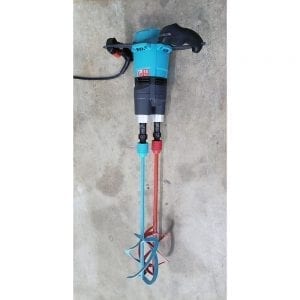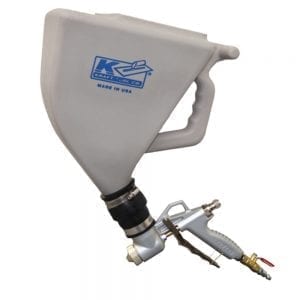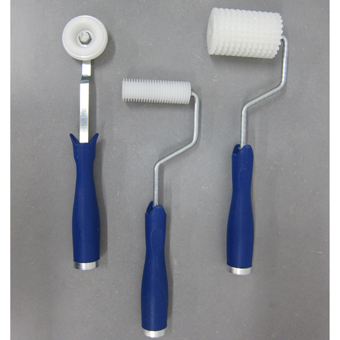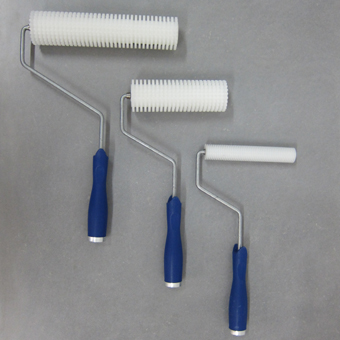GFRC requires specialized equipment to mix and cast. This page explains which equipment to use and why.
Mixer
The mixing procedure for GFRC is very important. GFRC must be high shear mixed. GFRC is very sensitve to the mix consistency – viscosity, flowability, workability. The basic GFRC mix design has been proportioned to make it very easy to crete a flowable mix design and still use a low water-cement ratio for strong concrete.
In ordinary concrete mix design, which is aggregate rich, the traditional way to create a flowable mix is to use quite a bit of a very powerful superplasticizer. The mix is intended to be poured into a mold that fills by gravity. In contrast, GFRC is sprayed onto the surface of a mold that may be vertical or even upside down. The mix has to be flowable so it can be sprayed and achieve a very high quality surface finish with no pinholes, but it also has to stick to the mold. Trying to make a flowable GFRC mix by using superplasticizer in the same amounts and methods for conventional concrete will result in a mix that won’t stick or is too runny.
In addition, because GFRC uses a cement-rich mix, the mix is sensitive to good cement particle dispersion for high early strength and quick set times. What high shear mixing does is it mechanically disperses the clumped cement particles rather than relying on large aggregate and large amounts of superplasticizer to do the same thing. With conventional concrete, the large aggregate (gravel) creates shearing action as it tumbles in the mixer. GFRC needs mechanical mixing at high energy to achieve that cement dispersion. You cannot use the conventional barrel/tumble style precast mixers for GFRC. They are too slow and don’t put enough energy into the mix.
High shear mixing takes only a minute. Here’s how to do it:
- Using a paddle style mixer such as the hand-held Collomix Xo6 or Xo55, simply mix at slow speed first to combine all the ingredients.
- Mix at high speed (greater than 500 rpm) for 30 seconds to 1 minute or until the mix is completely smooth and has loosened up.
- This must be done for both mist coat and backer coat. The backer coat is high sheared BEFORE the fibers are added, then the fibers are gently folded in.

Sprayer
An Inexpensive Starter Sprayer for GFRC Mist Coat
A simple drywall hopper gun can be used to spray a thin mist coat, and then you hand-apply layers of fibrous backer coat. We recommend the Kraft EZY Deck Pro hopper gun for spraying mist coat. It costs less than $100.
Not Recommended:
We do not recommend the Mortar Sprayer “3 Jet Stucco” backer coat sprayer. It is designed to spray non-fibrous mortar/stucco onto a wall, where precision isn’t important. When spraying GFRC backer through it, it is very hard to control the amount of material sprayed, which leads to variable strength in the final product. It spits out tons of material explosively, and you have to move FAST to make sure it doesn’t dump out too much (for a thin backer layer).
Nozzle Sizes
Most hopper guns come with a variety of nozzle sizes (4mm, 6mm and 8mm are common). The 6mm nozzle is a good all around choice.
- Smaller nozzles create a higher energy spray that lays down a thinner coat of material.
- Larger diameter nozzles lay down more material with a greater spread but with less energy.
- Thin mist coats that have very few pinholes are best achieved with smaller nozzles spraying more fluid mist coats.
Air Compressor
Your air compressor must be capable of delivering at least 6 CFM (cubic feet per minute) at 90 PSI continuously without loss of pressure or air flow.
Smaller air compressors will lose air flow quickly as the air tank is depleted. Smaller compressors often yield more variations in surface quality because the air pressure and flow rate change as the mist coat is being sprayed. Lengthy delays while spraying the mist coat will result in spray lines and visual defects in the visible surface.
The recommended air compressor is a 3HP 60 gallon stationary unit often capable of supplying around 10 CFM at 90 PSI.
Set the air compressor to maximum pressure (usually about 90 psi). The air will be controlled at the hopper gun.
Compaction Rollers: Essential for problem-free GFRC
Backer must be applied in thin coats (1/4″ or 6mm), and each coat must be compaction rolled to orient the fibers correctly and ensure bonding with the previous layer. This article explains why.
We have seen a disturbing trend in the concrete countertop industry of using a single thick coat of backer, or creating a flowable mix (“SCC”) and pouring in the backer. Perhaps this was a misguided attempt to save time, because hand-applying backer coats and rolling them takes the majority of time required to create GFRC. There are backer sprayers that can speed up production time when you are ready to upgrade to larger equipment. It could have been an attempt to save money by not having to buy compaction rollers. However, this approach is simply the wrong way to do GFRC and results in far lower tensile and flexural strength, which is the whole point of GFRC. It’s fine for small pieces, but blindly doing this without understanding the importance of compaction rolling for large pieces is dangerous. Click here for an article that explains the danger of this approach.
More about GFRC:
See this page for information about how to make GFRC, plus training options.



